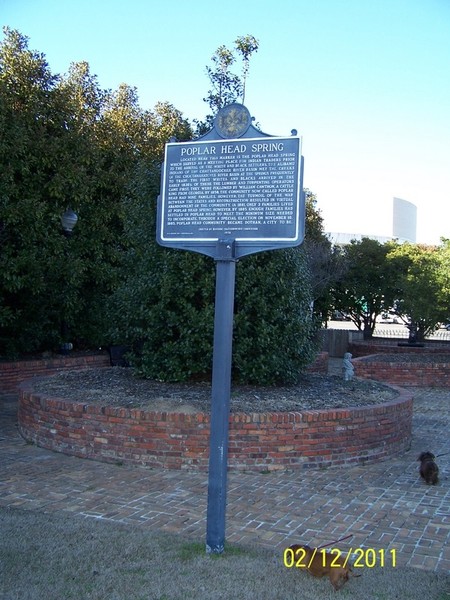Poplar Head Spring Historical Marker
Introduction
Text-to-speech Audio
Images
A photo of the historical marker commemorating the Poplar Head Spring.

Backstory and Context
Text-to-speech Audio
Long before American settlers entered this region, the freshwater spring just near this marker served as the meeting point between the Alibamu Indians of the Chattahoochee River basin and the Creeks of the Choctawahatchee River Basin. Native Americans have had a long history in the area, with the Creek War occurring in this region between 1813 and 1814. The Alibamu and the Creeks used this spring as a place to trade with one another before American settlers arrived in the early 1830s.
Settlers arrived in the early 1830s traveling in covered wagons all the way from Charleston, Savanna, and Jacksonville. Once they arrived and settled for camp at this spring, many of the travelers chose to move on, deciding that the sandy dirt and thick pine forests would make farming difficult. The families that stayed behind eventually formed the small community of Poplar Head, which by 1858 consisted of nine families. Originally the community consisted mainly of Lumber and Turpentine craftsmen, making the community a small trading village.
Once the Civil War started, however, the community was practically abandoned and barely survived. As the Civil War went on, communities in the south were terrorized by deserters and draft evaders who rode freely around the region, raiding communities and travelers. In 1863 the Confederate forces attempted to stop these raiders by launching a campaign down Cowarts Creek to their secret headquarters just across the Florida state line. Initially, the raiders repelled the Confederate forces but were defeated at the battle of Newton in 1865.
In 1881 only 3 families still lived at Poplar Head. However, by 1885 the population had grown as more families had settled in the area once again, giving the community enough individuals to meet the minimum size needed to incorporate into a town. When the community attempted to petition for a post office and become a town, however, they were informed that another community in Alabama had already taken the name Poplar Head. A minister of the community helpfully suggested the name Dothan. Through a special election, on November 10th, 1885, the Poplar Head community became Dothan.
In 1978 a historical marker was erected by the Historic Chattahoochee Commission to honor the starting point of Dothan.
Sources
Dothan Area Chamber of Commerce. About Dothan, Alabama, Dothan AL. Accessed November 24th 2020. https://www.dothan.org/474/About-Dothan.
Cox, Dale. Dothan, Alabama - Historic Sites & Points of Interest, ExploreSouthernHistory.com. October 3rd 2013. Accessed November 24th 2020. https://exploresouthernhistory.com/dothan.html.
Gaines, David J.. Poplar Head Spring, Historical Marker Database. July 25th 2018. Accessed November 24th 2020. https://www.hmdb.org/m.asp?m=41141.
Photo taken by David J Gaines. Image sourced from HMDB.org at: https://www.hmdb.org/m.asp?m=41141
